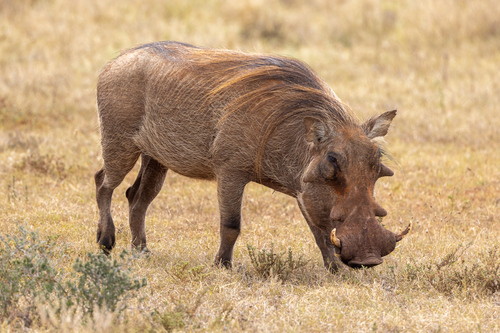
Common Warthog
The common warthog, with its unique facial warts and impressive tusks, thrives in Africa's savannas. Known for their social nature, these hardy animals dig for roots and tubers, playing a crucial role in their ecosystem by aiding soil aeration and plant growth.
12-18 years
Lifespan
50.0 - 150.0 kg
Weight
Brown, Grey, Tan
Color
30 mph
Top Speed
Least Concern
Conservation Status
Decreasing
Population Trend
Characteristics
Phacochoerus africanus, commonly known as the common warthog, is characterized by its distinctive facial warts, large curved tusks, and a tufted tail. Native to the savannas and grasslands of Africa, they are social and diurnal, often seen in groups called sounders. They are adept at using their snouts and tusks to dig for food.
Distribution Range of the Common Warthog
Phacochoerus africanus, commonly known as the common warthog, is native to sub-Saharan Africa. Its geographical distribution includes countries such as South Africa, Namibia, Botswana, Zimbabwe, Mozambique, and parts of East Africa including Kenya, Tanzania, and Uganda. The species is also found in the Sahel region of West Africa, extending to countries like Senegal and Mali.
Common Warthog's Habitat
Environmental Conditions
The common warthog typically inhabits savannas, grasslands, and open woodlands. It is adapted to live in areas with seasonal rainfall and can be found in regions with a mix of grass and woodland. Warthogs prefer habitats that have a good supply of water and are often found in areas with sparse trees or shrubs.
Ecological Niche
Phacochoerus africanus occupies the niche of a grazer and browser in its ecosystem. It primarily feeds on grasses, roots, berries, and bark, using its snout and tusks to dig. Warthogs are important for maintaining grassland ecosystems by controlling vegetation growth and creating burrows that provide shelter for other species. They are also known to form symbiotic relationships with birds like oxpeckers, which help remove parasites from their skin.
Copyright @ Nature Style Limited. All Rights Reserved.
 English
English